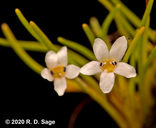Taxon Report
Limosella australis R. Br.Delta mudwort |
 © 2020 Richard Sage |
Taxon Summary
Limosella australis, commonly known as Delta mudwort, is a perennial stoloniferous herb in the Scrophulariaceae that is found in California and elsewhere. It occurs within Marshes and swamps (brackish, freshwater), and Riparian scrub, growing at elevations from 0 to 3 meters. Limosella australis is ranked 2B.1, Plants Rare, Threatened, or Endangered in California, But More Common Elsewhere; Seriously threatened in California.Classification
|
Scientific Name: |
Limosella australis R. Br. |
|
Common Name: |
Delta mudwort |
| Family: | Scrophulariaceae |
| Element Code: | PDSCR10030 |
| USDA Plants Symbol: | LIAU6 |
|
Synonyms/Other Names: |
|
Ecology and Life History
| Lifeform: | perennial stoloniferous herb |
| Blooming Period: May-Aug | May-Aug |
| Elevation: | 0-3 (0-10) |
| General Habitats: | Marshes and swamps, Riparian scrub |
| Microhabitat: | Streambanks (usually) |
| Microhabitat Details: | Usually mud banks |
Conservation Status
| CA Rare Plant Rank: | 2B.1 |
| Global Rank: | G5 |
|
State Rank: |
S2 |
| State List: | None |
| Fed List: | None |
| Other Status: | |
|
CRPR Changes: |
|
Occurrence Data from the CNDDB
| Total Occurrences: | 59 |
| Element Occurrence Ranks: | |
| Excellent (A) | 5 |
| Good (B) | 30 |
| Fair (C) | 11 |
| Poor (D) | 2 |
| None (X) | 0 |
| Unknown (U) | 11 |
| California Endemic: False | |
| California Counties and Islands: Name (Code) | |
| Contra Costa (CCA), Sacramento (SAC), San Joaquin (SJQ), Solano (SOL) | |
| Quads: Name (Quad Code) | |
| Antioch North (3812117), Bouldin Island (3812115), Bruceville (3812134), Clifton Court Forebay (3712175), Courtland (3812135), Dozier (3812137), Holt (3712184), Honker Bay (3812118), Isleton (3812125), Jersey Island (3812116), Rio Vista (3812126), Terminous (3812114), Thornton (3812124), Vine Hill (3812211), Woodward Island (3712185) | |
Threat List Data from the CNDDB
| Threat List Total: | 10 | |
| EOs with Threat Listed: | Total EOs | % of EOs |
| 36 | 61 % | |
| Recreational use (non-ORV) | 25 | 42% |
| Erosion/runoff | 14 | 23% |
| Foot traffic/trampling | 6 | 10% |
| Altered flood/tidal/hydrologic regime | 3 | 5% |
| Vandalism/dumping/litter | 3 | 5% |
| Waterway bank protection/maintenance | 3 | 5% |
| Other | 3 | 5% |
| Non-native plant impacts | 2 | 3% |
| Degraded water quality | 2 | 3% |
| Grazing | 1 | 1% |
Notes
| Threatened by stream bank alteration, levee maintenance, erosion, recreational activities, and foot traffic. Also occurs on the Atlantic Coast, where threatened by habitat destruction. Native status in CA is inconclusive; definitive study needed. Treated as naturalized in TJM (1993) and TJM 2. See Prodromus Florae Novae Hollandiae 1:443 (1810) for original description. |
|
Threats: |
|
Taxonomy: |
Citation
California Native Plant Society, Rare Plant Program. 2025. Rare Plant Inventory (online edition, v9.5.1). Website https://www.rareplants.cnps.org [accessed 22 December 2025].